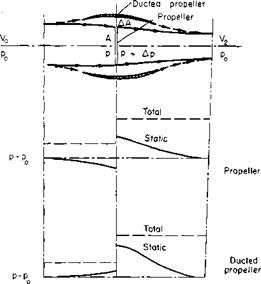Ducted Propeller in Axial Flight
Ducting the propeller, that is, encasing it in a shroud, allows us to maintain loading on the propellef blades all the way out to the tips of the blades. Also, by suitably shaping the shroud a thrust can be developed on the shroud itself. The treatment of the shroud follows that presented in Ref. 1. Although approximate in nature, it readily discloses aspects of ducted propellers that are obscured by more exact treatments. First, as for the open propeller, consider some elementary momentum principles.
The flow through an open propeller and through a ducted propeller are superimposed over one another in Fig. 9-2. Both propellers are designed
|
Fig. 9-2. Comparison of flow through a ducted propeller with an open propeller. |
for the same mass flow rate and velocity in the ultimate wake V2. The open propeller has a disk area of A, whereas the disk area of the shrouded propeller is A + A A. Thus in this case the shroud is designed to diffuse the flow.
A discontinuity in the pressure Ap exists across each disk. From Eq. (4-6) this is given by
AP = (*У – Vl). (9-1)
The thrust of the open propeller is
Topen = ApA,
whereas that of the ducted propeller, henceforth referred to as the rotor, is

TR = Ap(A + AA)
If the useful power is defined at TV0, then, as in Chapter 4, the ideal efficiency can be defined by
For the open propeller, T = 2mw, and (9-7) and (9-8) reduce to (4-11). A combination of (9-8) and (9-6) leads to
y = fo «n/Г^С^Г1. (9-9)
Equation (9-9) shows that for a given net thrust the rotor thrust increases as the static pressure ahead of the rotor is increased. To state this another way, if the duct is shaped to decrease the axial velocity at the rotor, the total thrust of the duct-propeller combination will be less than that produced by the rotor. Conversely, if the flow is accelerated by the duct, the duct will develop a thrust that will add to the thrust of the rotor.
As in the case of the open propeller, momentum considerations define limitations on the operation of the ducted propeller but are insufficient for actual design purposes. For this we once again turn to the application of equivalent vortex systems.












